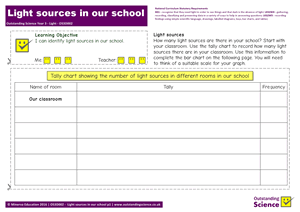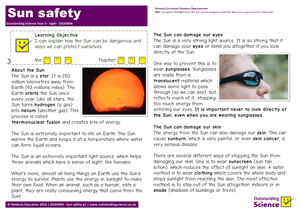

I can investigate how moving a light source changes the size of an object's shadow.
Children investigate how moving a light source affects the size of an object's shadow. They predict and then measure the width of the shadow cast when the light source is at a range of distances. They transfer their results from their table to a bar chart. Finally, they attempt to explain the relationship between light source distance and shadow size.
I can identify light sources.
Children learn that we see things because they are either light sources that make light, and that we see them because light travels directly into our eyes, or they are non-light sources that we can see because light reflects off them into our eyes. They cut out 12 different images and place them into 2 groups - light sources and non-light sources.

2 pages
I can identify light sources in our school.
Children investigate the number of light sources in the different rooms in their school, starting with their classroom. They record their findings on a tally chart which they then turn into a frequency table. Finally, children display their results on a horizontal bar chart, selecting a suitable scale for their graph. They discuss what a light source is, how most light sources are powered and why different rooms have different numbers of light sources.

2 pages
I can identify whether an object is a light source or a reflector.
Children learn that some objects are visible because they are light sources and some are visible because they reflect light. Children look at 9 different images of objects that help us to see at night. They identify whether they are light sources or reflectors, and place them on a single-set Venn diagram to record their classification.

2 pages
I can explain how the Sun can be dangerous and ways we can protect ourselves.
Children learn about the importance of the Sun as the ultimate energy source for all life on Earth. They also learn about different ways in which exposure to the Sun can be dangerous to humans. Children explain, and illustrate, ways in which the Sun can damage our eyes and skin and ways that this damage can be minimised.

2 pages
I can explain how shadows are formed.
Children learn that shadows are formed when an opaque object blocks the path of light, which travels in straight lines. They use a light source to cast an object's shadow onto a piece of paper and draw around the outline. They investigate and explain into how the shape of an object affects its shadow.

1 page
I can group objects according to whether they are transparent, translucent, or opaque.
Children learn that we can classify objects as transparent, translucent or opaque depending on how light behaves when it hits them. They carry out an investigation to classify a selection of classroom objects as transparent, translucent, or opaque. They display their findings in a Venn diagram with 2 sets, one nested inside the other.

2 pages
I can make a sundial and explain how it works.
Children learn that shadows cast by the Sun change in length and direction during the day because of the apparent motion of the Sun across the sky (though this is really caused by the roration of the Earth). Using a gnomon (such as a cricket wicket) and chalk, children create their own sundial on the yard. They calibrate their sundial and explain how it works.

1 page